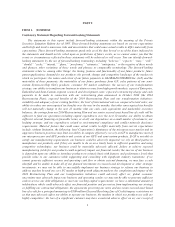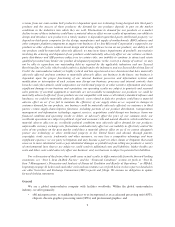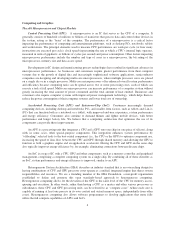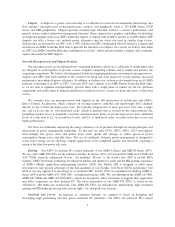AMD 2014 Annual Report Download - page 17
Download and view the complete annual report
Please find page 17 of the 2014 AMD annual report below. You can navigate through the pages in the report by either clicking on the pages listed below, or by using the keyword search tool below to find specific information within the annual report.Third-Party Distributors
Our authorized channel distributors resell to sub-distributors and mid-sized and smaller OEMs and ODMs.
Typically, distributors handle a wide variety of products, including those that compete with our products.
Distributors typically maintain an inventory of our products. In most instances, our agreements with distributors
protect their inventory of our products against price reductions and provide return rights with respect to any
product that we have removed from our price book that is not more than 12 months older than the manufacturing
code date. In addition, some agreements with our distributors may contain standard stock rotation provisions
permitting limited levels of product returns.
Add-in-Board (AIB) Manufacturers and System Integrators
We offer component-level graphics and chipset products to AIB manufacturers who in turn build and sell
board-level products using our technology to system integrators (SIs), and to retail buyers. Our agreements with
AIBs protect their inventory of our products against price reductions. We also sell directly to our SI customers.
SIs typically sell from positions of regional or product-based strength in the market. They usually operate on
short design cycles and can respond quickly with new technologies. SIs often use discrete graphics solutions as a
means to differentiate their products and add value to their customers.
Competition
Generally, the IC industry is intensely competitive. Products typically compete on timely product
introductions, product quality (including enabling state-of-the art visual experiences), power consumption
(including battery life), reliability, processor clock speed, performance, size (or form factor), selling, price, cost,
adherence to industry standards (and the creation of open industry standards), level of integration, software and
hardware compatibility and stability, brand recognition and availability. Technological advances in the industry
result in frequent product introductions, regular price reductions and short product life cycles for some products,
and increased product capabilities that may result in significant performance improvements. Our ability to
compete depends on our ability to develop, introduce and sell new products or enhanced versions of existing
products on a timely basis and at competitive prices, while reducing our costs.
Competition in the Microprocessor and Chipset Market
Intel Corporation has been the market share leader for microprocessors for many years. Intel’s market share,
margins and significant financial resources enable it to market its products aggressively, to target our customers
and our channel partners with special incentives and to influence customers who do business with us. These
aggressive activities have in the past and are likely in the future to result in lower unit sales and a lower average
selling price for many of our products and adversely affect our margins and profitability.
As long as Intel remains in this dominant position, we may be materially adversely affected by Intel’s:
• business practices, including rebating and allocation strategies and pricing actions, designed to limit our
market share and margins;
• product mix and introduction schedules;
• product bundling, marketing and merchandising strategies;
• exclusivity payments to its current and potential customers and channel partners;
• control over industry standards, PC manufacturers and other PC industry participants, including
motherboard, memory, chipset and basic input/output system, or BIOS, suppliers and software
companies as well as the graphics interface for Intel platforms; and
• marketing and advertising expenditures in support of positioning the Intel brand over the brand of its
OEM customers.
Intel exerts substantial influence over computer manufacturers and their channels of distribution through
various brand and other marketing programs. As a result of Intel’s position in the microprocessor market, Intel
11
























